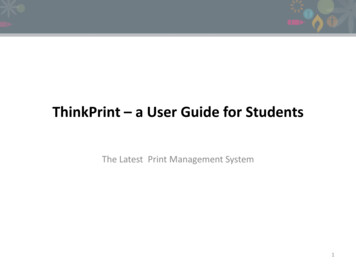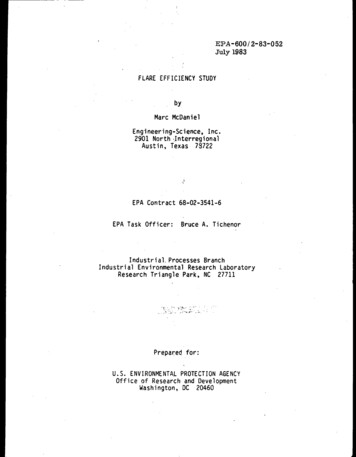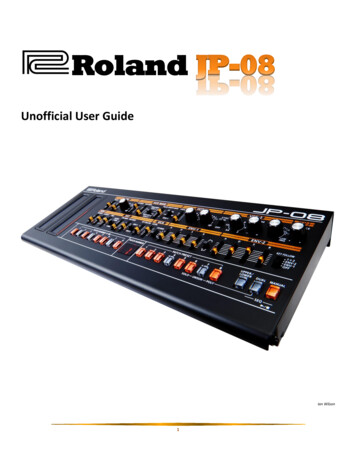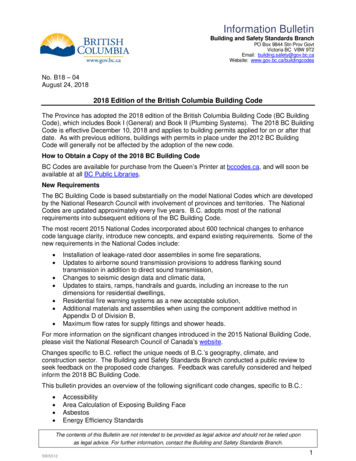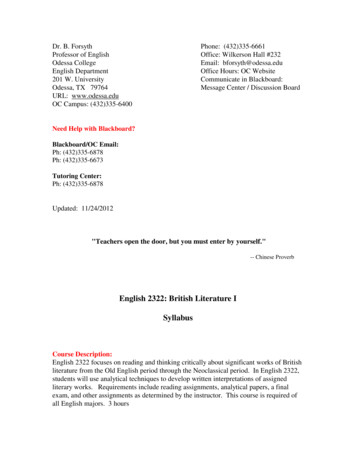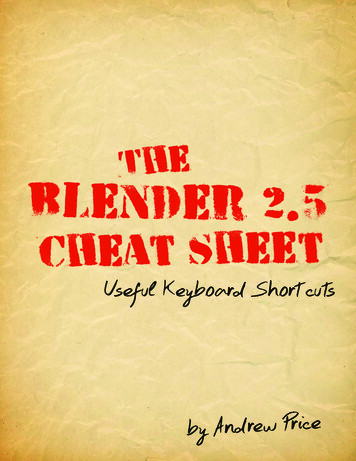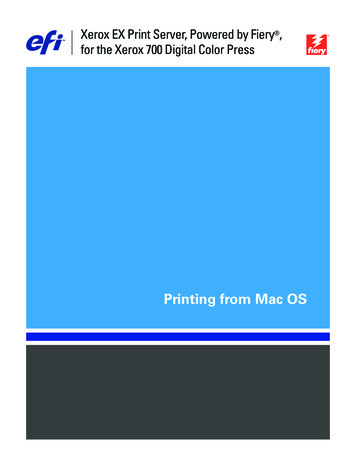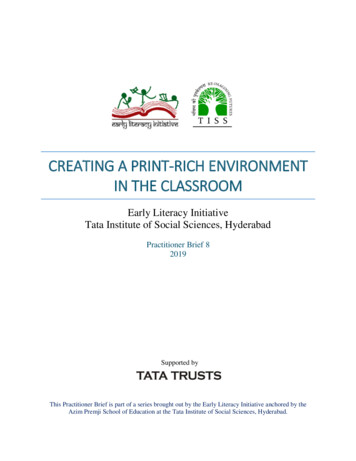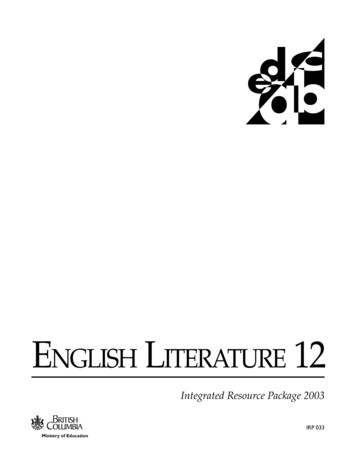
Transcription
ENGLISH LITERATURE 12Integrated Resource Package 2003IRP 033Ministry of Education
Copyright 2003 Ministry of Education, Province of British Columbia.Copyright NoticeNo part of the content of this document may be reproduced in any form or by any means, including electronic storage,reproduction, execution or transmission without the prior written permission of the Province.Proprietary NoticeThis document contains information that is proprietary and confidential to the Province. Any reproduction,disclosure or other use of this document is expressly prohibited except as the Province may authorize in writing.Limited Exception to Non-reproductionPermission to copy and use this publication in part, or in its entirety, for non-profit educational purposes withinBritish Columbia and the Yukon, is granted to all staff of B.C. school board trustees, including teachers andadministrators; organizations comprising the Educational Advisory Council as identified by Ministerial Order; andother parties providing direct or indirect education programs to entitled students as identified by the School Act or theIndependent School Act.
TABLE OF CONTENTSAcknowledgments . . . . . . . . . . . . . . . . . . . . . . . . . . . . . . . . . . . . . . . . . . . . . . . . . . . . . . . . IIPREFACE: USING THIS INTEGRATED RESOURCE PACKAGEPreface . . . . . . . . . . . . . . . . . . . . . . . . . . . . . . . . . . . . . . . . . . . . . . . . . . . . . . . . . . . . . . . . . IIIINTRODUCTION TO ENGLISH LITERATURE 12Rationale . . . . . . . . . . . . . . . . . . . . . . . . . . . . . . . . . . . . . . . . . . . . . . . . . . . . . . . . . . . . . . . .Changes to this Curriculum . . . . . . . . . . . . . . . . . . . . . . . . . . . . . . . . . . . . . . . . . . . . . . . .Specified Readings . . . . . . . . . . . . . . . . . . . . . . . . . . . . . . . . . . . . . . . . . . . . . . . . . . . . . . . .Curriculum Organizers . . . . . . . . . . . . . . . . . . . . . . . . . . . . . . . . . . . . . . . . . . . . . . . . . . . .Planning for Instruction . . . . . . . . . . . . . . . . . . . . . . . . . . . . . . . . . . . . . . . . . . . . . . . . . . . .Integration of Cross-Curricular Interests . . . . . . . . . . . . . . . . . . . . . . . . . . . . . . . . . . . . .Suggested Assessment Strategies . . . . . . . . . . . . . . . . . . . . . . . . . . . . . . . . . . . . . . . . . . . .Learning Resources . . . . . . . . . . . . . . . . . . . . . . . . . . . . . . . . . . . . . . . . . . . . . . . . . . . . . . .12356677CURRICULUM: ENGLISH LITERATURE 12Curriculum . . . . . . . . . . . . . . . . . . . . . . . . . . . . . . . . . . . . . . . . . . . . . . . . . . . . . . . . . . . . . 10ENGLISH LITERATURE 12 APPENDICESAppendix A: Prescribed Learning Outcomes . . . . . . . . . . . . . . . . . . . . . . . . . . . . . . . .Appendix B: Learning Resources . . . . . . . . . . . . . . . . . . . . . . . . . . . . . . . . . . . . . . . . . .Appendix C: Assessment and Evaluation . . . . . . . . . . . . . . . . . . . . . . . . . . . . . . . . . . .Appendix D: Key Literary Terms . . . . . . . . . . . . . . . . . . . . . . . . . . . . . . . . . . . . . . . . . .A-3B-3C-3D-3ENGLISH LITERATURE 12 I
ACKNOWLEDGEMENTSMany people contributed their expertise to this document. The project co-ordinator wasMargaret Haughian of the Content Standards Branch, working with ministry personnel and ourpartners in education. We would like to thank all who participated in this process.THE IRP WRITING AND RESOURCE EVALUATION TEAMTina GrabenhorstSchool District No. 43 (Coquitlam)Joan HallSchool District No. 36 (Surrey)Doreen KennedySchool District No. 39 (Vancouver)Jill MartinSchool District No. 61 (Victoria)June WilsonSchool District No. 46 (Sunshine Coast)II ENGLISH LITERATURE 12
PREFACE: USING THIS INTEGRATED RESOURCE PACKAGEThis Integrated Resource Package (IRP)provides basic information teacherswill require in order to implement theEnglish Literature 12 curriculum. Thisdocument supersedes the English Literature12 Integrated Resource Package (1996). Theinformation contained in this IRP is alsoavailable via the Ministry web site:http://www.bced.gov.bc.ca/irp/irp.htm.The following paragraphs provide briefdescriptions about each section of the IRP.THE INTRODUCTIONThe Introduction provides generalinformation about English Literature 12,including special features and requirements.It also provides a rationale for teachingEnglish Literature 12 in BC schools.THE ENGLISH LITERATURE 12 CURRICULUMThe provincially prescribed curriculum forEnglish Literature 12 is structured in terms ofcurriculum organizers. The main body ofthis IRP consists of four columns ofinformation for each organizer. Thesecolumns provide provincially prescribed learning outcomestatements suggested instructional strategies forachieving the outcomes suggested assessment strategies fordetermining how well students areachieving the outcomes additional information, includinginformation about provinciallyrecommended learning resources.Prescribed Learning OutcomesLearning outcome statements are contentstandards for the provincial educationsystem. Prescribed learning outcomes set outthe knowledge, enduring ideas, issues,concepts, skills, and attitudes for eachsubject. They are statements of what studentsare expected to know and be able to do ineach grade. Learning outcomes are clearlystated and expressed in observable terms. Alllearning outcomes complete the stem: “It isexpected that students will.” Outcomestatements have been written to enableteachers to use their experience andprofessional judgment when planning andevaluating. The outcomes are benchmarksthat will permit the use of criterionreferenced performance standards. It isexpected that actual student performancewill vary. Evaluation, reporting, and studentplacement with respect to these outcomesdepend on the professional judgment ofteachers, guided by provincial policy.Suggested Instructional StrategiesInstruction involves the use of techniques,activities, and methods that can be employedto meet diverse student needs and to deliverthe prescribed curriculum. Teachers are freeto adapt the suggested instructionalstrategies or substitute others that willenable their students to achieve theprescribed learning outcomes. Thesestrategies have been developed by specialistteachers to assist their colleagues; they aresuggestions only.Suggested Assessment StrategiesThe assessment strategies suggest a varietyof ways to gather information about studentperformance. Some assessment strategiesrelate to specific activities; others are general.These strategies have been developed byspecialist teachers to assist their colleagues;they are suggestions only.ENGLISH LITERATURE 12 III
PREFACE: USING THIS INTEGRATED RESOURCE PACKAGEProvincially Recommended LearningResourcesProvincially recommended learningresources are materials that have beenreviewed and evaluated by BC educators incollaboration with the Ministry of Educationaccording to a stringent set of criteria. Theseresources are organized as GradeCollections. A Grade Collection is the formatused to organize the provinciallyrecommended learning resources by gradeand by curriculum organizer. It can beregarded as a “starter set” of basic resourcesto deliver the curriculum. With very fewexceptions, learning resources listed inGrade Collections will be the onlyprovincially evaluated and recommendedlearning resources. They are typicallymaterials suitable for student use, but theymay also include information primarilyintended for teachers. Teachers and schooldistricts are encouraged to select thoseresources that they find most relevant anduseful for their students, and to supplementthese with locally approved materials andresources to meet specific local needs.THE APPENDICESA series of appendices provides additionalinformation about the curriculum, andfurther support for the teacher. Appendix A lists the curriculum organizersand the prescribed learning outcomes foreach grade for the curriculum. Appendix B consists of generalinformation on learning resources,including Grade Collections and selectinglearning resources for the classroom. TheGrade Collections for English Literature 12follow, comprising grade-levelorganizational charts and alphabeticalannotated lists of the provinciallyrecommended resources. New resourcesare evaluated on an ongoing basis, and thenew provincial recommendations areposted on the Ministry web site: http://www.bced.gov.bc.ca/irp resources/lr/resource/consub.htmTeachers are advised to check the web siteon a regular basis. Appendix C contains assistance forteachers regarding provincial evaluationand reporting policy. Prescribed learningoutcomes have been used as the source forsamples of criterion-referencedevaluations. Appendix D contains a list of key literaryterms that are required for study inEnglish Literature 12.IV ENGLISH LITERATURE 12
PREFACE: USING THIS INTEGRATED RESOURCE PACKAGEGradeENGLISH LITERATURE 12 Critical and Personal Response to LiteraturePRESCRIBED LEARNING OUTCOMESPrescribed LearningOutcomesThe Prescribed LearningOutcomes column liststhe specific learningoutcomes foreach curriculumorganizer .It is expected that students will: demonstrate an awareness of why literature isvalued demonstrate an awareness of the influences ofgender, ethnicity, and class on literature demonstrate respect for ideas and values expressedin literary works demonstrate an appreciation of oral and visualperformance of literary works identify and interpret issues and themes in literaryworks demonstrate a willingness to be open-minded andrespectful of diverging interpretations of literaryworks demonstrate a willingness to make personalconnections with characters and experiences inliterary works create personal responses to literature throughwriting, speech, or visual representation demonstrate confidence in oral readingSUGGESTED INSTRUCTIONAL STRATEGIES Grade Suggested AssessmentStrategiesThe SuggestedAssessment Strategiesoffer a wide range ofassessment approachesuseful in evaluatingthe prescribedlearning outcomes.Teachers should considerthese as examples theymight modify to suittheir own needs andinstructional goals.Ask students to generate criteria for evaluating literarymerit. Have them pay particular attention to the roles ofgender, ethnicity, and class.Have students use a journal regularly when pre-readingworks and after studying the works in class to ask questions,express opinions, and note personal connections.Encourage students to utilize hypertext to demonstrateunderstanding of a work by creating links between the textof the work and related art, music, or other writingsavailable at Internet websites.Have students use the differing attitudes of two authors on aparticular theme as the basis for a debate (e.g., Wordsworth,Arnold, or Smith on nature; Brontë, Tennyson, Thomas, orEliot on death). Debaters could perform in role.Encourage students to find a creative way to visually presentor interpret a work.Have students use index cards to create study notes on eachof the specified readings. Colour-code each time period andinclude a card outlining the characteristics of each timeperiod. Each card should include author, title, form of poem,poetic devices, one or more quotations, analysis of poem,and aspects of period.Organize a field trip to a live theatre performance.Have students write and perform songs that summarize awork, describe a character, or focus on an author.Have students prepare and present at least two oral readingsof a piece on video or tape. With a partner or small group,the student listens to both versions and chooses the strongestperformance, noting reasons for the choice. This could alsobe done with choral readings.Create a Poetry Coffee House, where each student selectsand reads a poem or excerpt.ENGLISH LITERATURE 12 Critical and Personal Response to LiteratureSUGGESTED ASSESSMENT STRATEGIES Ask students, individually or in a group, todramatize a scene from a work or present a readingas a way of assessing their comprehension. Whenthey read or act out selections, look for evidence thatthey- have analysed the texts to determine appropriateactions and expressions- are comfortable with the language- consciously adjust vocal expression, body language,actions, appearance, and phrasing to enhancelisteners’ understanding and engagement- understand the characters they portray- offer interpretations consistent with the themes.You may wish to check the efficacy of the studycards by administering an exam during which thestudents may refer to their cards.In assessing creative assignments related to a majorliterary work, consider the extent to which students- reveal a personal voice or perception- reveal insight into more than just plot- relate knowledge of the author’s personalcircumstances (especially gender, ethnicity, class) totheir understanding of the work- provide a unique way for peers to see an aspect ofthe work.To check on students’ knowledge and have themreview a specific work or group of works. Ask eachstudent, in turn, to offer one piece of informationthey remember (e.g., Hamlet had a father; Opheliadied). Continue until no one can think of anotherpiece of information. (This activity could beconducted as a “literature bee” or relay, in whichstudents sit down when they can no longercontribute anything new in their turn.)theCurriculum Organizerand SuborganizerSuggested InstructionalStrategiesThe SuggestedInstructional Strategiescolumn suggests a varietyof instructional approachesthat include group work,problem solving, and theuse of technology. Teachersshould consider these asexamples they mightmodify to suit thedevelopmental levelof their students.Curriculum Organizerand SuborganizerRECOMMENDED LEARNING RESOURCESAND ADDITIONAL INFORMATIONThe English Literature 12 Grade Collection, annotations,and ordering information can be found in Appendix B ofthis document.The most current listing of recommended learningresources can be found on theMinistry web site at http:/www.bced.gov.bc.ca/irp resources/lr/resource/gradcoll.htm. The following works can readily be used as the basisfor an effective interpretive visual presentation:- The Prologue to the Canterbury Tales (Chaucer’spilgrims)- Shakespeare’s sonnets- Gray’s “Elegy Written in a Country Churchyard.”RecommendedLearning Resources &AdditionalInformationThis column lists thecomprehensive textsrecommended for thiscourse, notes onspecified selections,and the ministry website where the mostcurrent listing ofrecommendedresources can befound.ENGLISH LITERATURE 12 V
INTRODUCTION TO ENGLISH LITERATURE 12his Integrated Resource Package (IRP)sets out the provincially prescribedcurriculum for English Literature 12.The development of this Integrated ResourcePackage has been guided by the principles oflearning:TStudents who pursue studies in other areaswill find the awareness of universal humanexperience and the disciplined use ofimaginative capacity associated with thestudy of English Literature 12 a criticalcomplement to their other work. Learning requires the active participationof the student. People learn in a variety of ways and atdifferent rates. Learning is both an individual and a groupprocess.The English Literature 12 course addresseseach of the three provincial goals ofeducation:RATIONALEThis course provides a basis for lifelonglearning as students read for pleasure,personal growth, and intellectual challenge.It also offers students a sound foundation formany career options.The aim of English Literature 12 is to enhancestudents’ literacy through the study of a bodyof works representative of the literaryheritage of English-speaking peoples. EnglishLiterature 12 offers senior studentsopportunities to examine and appreciate thisrich heritage.Research has shown that reading widely is animportant factor in academic success. Byreading works that are sophisticated inthought and style, English Literature 12students strengthen the skills needed toacquire information accurately and makeinformed judgments. Such skills are vital forthe educated citizen and lifelong learner.The study of great works of English literatureincreases students’ interpersonal skills,aesthetic appreciation, and critical judgment.In addition, it promotes the development ofstrong communication skills, intellectualdiscipline, and the open-mindednessrequired for the world of work and furtherlearning. Students who will go on to studyEnglish literature or related humanitiessubjects will benefit from exposure to theoverview and the sense of literature’shistorical place provided in this course. intellectual development human and social development career development.Intellectual DevelopmentEnglish Literature 12 offers studentsopportunities to study significant works written in English explore a broad range of literature in itshistorical context develop increasingly sophisticated skills inthe interpretation and analysis of literature develop precision in the use of language develop creative and critical-thinkingskills appreciate the power of literature toexpress the human experience refine critical discernment with respect toliterature.Human and Social DevelopmentEnglish Literature 12 offers studentsopportunities to examine and appreciate the diversity andcommonality of the human experienceENGLISH LITERATURE 12 1
INTRODUCTION TO ENGLISH LITERATURE 12 develop a deeper respect for the range ofvoices within English literature andEnglish-speaking societies appreciate an evolving historical andcultural tradition engage in a shared literary experience engage in philosophical reflection develop and refine personal values develop artistic sensitivity explore the creative process derive pleasure from literature become lifelong and discriminatingreaders.Career DevelopmentEnglish Literature 12 offers studentsopportunities to develop the thinking and communicationskills important in all careers develop the flexibility of thought valuedby prospective employers in an evolvingjob market develop the skills and cultural literacyimportant in fields specifically concernedwith language, communication, andculture (e.g., anthropology, art history,counselling, education, film, journalism,music, law, personnel management,philosophy, psychology, publishing, sales,social work, sociology, television, theatre,and tourism) use information technology for researchand presentation develop an awareness of the power ofstory and metaphor as a basis for sharingideas and forging common purposes inworking situations.CHANGES TO THIS CURRICULUMIn the past, the province’s Grade 12 EnglishLiterature courses were chronologicalsurveys of the major figures of Britishliterature from Anglo-Saxon times to WorldWar I. The 1996 revision of the courseexpanded its scope to include later 20thcentury literature and works of Englishspeaking writers from Canada, otherCommonwealth countries, and the UnitedStates.This 2003 revision retains a focus on thedevelopment of thought and cultureexpressed in English literary text. Whileretaining an emphasis on the history ofliterature in English and a requirement forstudents to study particular texts that reflectthis history (specified readings), the coursestill includes opportunities for teachers toselect the texts that they feel best representthis tradition. As well, this revision removesthe modular structure of the previouscurriculum and introduces a revised,simplified set of curriculum organizers forthe course.The course still encompasses a range ofvoices throughout history that havecontributed to the development of ourEnglish literary heritage. This range includeswriting by men and women from varioussocial classes and ethnic backgrounds. Inaddition to works originally written inEnglish, the course may include translatedliterature from the classical and medievalperiods that has influenced the growth of thisliterary tradition.The curriculum emphasizes students’developing intellectual, aesthetic, andaffective responses to text. Literary texts arestudied both as works of art for close readingand as cultural reflections of social, political,and historical forces.2 ENGLISH LITERATURE 12
INTRODUCTION TO ENGLISH LITERATURE 12SPECIFIED READINGSThe resources listed in the accompanyingtable, “Specified Readings,” have beenmandated in the prescribed learningoutcomes for Literature 12. One criterion forselecting these readings is that they aregenerally available in the anthologiesdesignated by the Ministry of Education asRecommended Resources for Literature 12: Adventures in English Literature, AthenaEdition (Holt, Rinehart and Winston). Literature: Timeless Voices, TimelessThemes—The British Tradition, vol. I & II(Prentice Hall)The prescribed learning outcomes also makeit clear, however, that students are to haveopportunities to study works of literature inEnglish beyond those listed in the table. Thechoice of these additional readings isdiscretionary—to be made by the Literature12 teacher, with student input asappropriate.For up-to-date information on how readingsand other concepts related to the EnglishLiterature 12 course may be addressed inprovincial examinations, please refer to theprovincial examinations section of theMinistry of Education web site at http://www.bced.gov.bc.ca/exams/about exams.htm .ENGLISH LITERATURE 12 3
INTRODUCTION TO ENGLISH LITERATURE 12Specified ReadingsAnglo-Saxon andMedieval From Beowulf,- “The Coming of Grendel,”- “The Coming of Beowulf,”- “The Battle with Grendel,”- “The Burning of Beowulf’s Body” (if using Athena edition)/“The Farewell” (if usingPrentice-Hall edition) from The Canterbury Tales, “The Prologue” “Bonnie Barbara Allan” (ballad) from Sir Gawain and the Green Knight, (lines 1 to the end if using Athena edition,and lines 259 to the end if using Prentice-Hall edition)Renaissance and17th Century 18th Century andRomantic Victorian and 20thCentury4 ENGLISH LITERATURE 12 Sir Thomas Wyatt, “Whoso List to Hunt”Christopher Marlowe, “The Passionate Shepherd to his Love”Sir Walter Raleigh, “The Nymph’s Reply to the Shepherd”William Shakespeare,- Sonnets 29, 116, 130;- Hamlet, King Lear, or The TempestJohn Donne,- “A Valediction: Forbidding Mourning,”- “Death be not proud ,”Robert Herrick, “To the Virgins”John Milton,- “On His Blindness”;- from Paradise Lost, Book I, lines 1-263Pepys, “The Fire of London”Lady Mary Chudleigh, “To the Ladies”Alexander Pope, from “The Rape of the Lock” (Canto III and V excerpts)Jonathan Swift, “A Modest Proposal”Robert Burns, “To a Mouse”William Blake, “The Tyger,” “The Lamb”Thomas Gray, “Elegy Written in a Country Churchyard”William Wordsworth,- “My Heart Leaps Up,”- “The World Is Too Much with Us”Samuel Taylor Coleridge, “The Rime of the Ancient Mariner”George Gordon, Lord Byron, “Apostrophe to the Ocean”Percy Bysshe Shelley, “Ode to the West Wind”John Keats,- “Ode to a Nightingale,”- “When I Have Fears ”Alfred, Lord Tennyson, “Ulysses”Elizabeth Barrett Browning, Sonnet 43Robert Browning, “My Last Duchess”Emily Brontë, “Song”Matthew Arnold, “Dover Beach”Thomas Hardy, “The Darkling Thrush”Emily Dickinson, “Because I Could Not Stop for Death”Wilfred Owen, “Dulce et Decorum Est”William Butler Yeats, “The Second Coming”T.S. Eliot, “The Hollow Men”Dylan Thomas, “Do Not Go Gentle into That Good Night”Stevie Smith, “Pretty”Margaret Atwood, “Disembarking at Quebec”
INTRODUCTION TO ENGLISH LITERATURE 12CURRICULUM ORGANIZERSThere are seven curriculum organizers onwhich all learning outcomes for the EnglishLiterature 12 curriculum are based. They are:Saxon and Medieval Britain. Students are notexpected to study original Anglo-Saxon orMiddle English texts, but will work withmodern English translations. Critical and Personal Response to Literature The Literary Tradition of the EnglishLanguage (Classical to Present) Anglo-Saxon and Medieval Literature Renaissance and 17th Century Literature 18th Century and Romantic Literature Victorian and 20th Century Literature Literary AnalysisRenaissance and 17th Century LiteratureCritical and Personal Response to LiteratureThe spiritual, political, and intellectualclashes of the 17th century are reflected inthe flavour of the literature, with its focus onspiritual truth and the structure of society.Through the experience of their personalconnections with themes, characters, andissues in the literature, students will have theopportunity to develop an intrinsic love forthe subject. Students are encouraged todevelop more informed, considered, andthoughtful responses to literature bybalancing and combining their personal,subjective opinions with their capacity forcritical reflection.The Literary Tradition of the EnglishLanguage (Classical to Present)This organizer gives teachers and students anopportunity to extend the scope of theirliterary studies beyond the particular readingsspecified under other curriculum organizers.The emphasis is on enabling students toacquire an awareness of both female and maleperspectives, as expressed in literary worksfrom various English-speaking countries orregions, written by authors of varying socialbackgrounds.Anglo-Saxon and Medieval LiteratureThis organizer provides opportunities forstudents to explore the origins of Englishlanguage literature within the cultural,geographical, and historical contexts of Anglo-During the period covered by this organizerEngland, like the rest of Europe, experiencedthe cataclysmic change from a single Churchsanctioned world view to greater intellectualdiversity. The new humanism of the age isexemplified in the drama and poetry of theRenaissance.18th Century and Romantic LiteratureThis organizer provides opportunities forstudents to appreciate the art of satire inpoetry and prose of the Enlightenment.Romantic literature invites students toexperience works that examine the humanrelationship with nature and focus on theimagination.Victorian and 20th Century LiteratureThis organizer provides opportunities forstudents to appreciate a distinctive change ofattitude associated with Queen Victoria’saccession to the English throne and thespread of English-language literature toother parts of the world. Victorian literaturereflects themes ranging from forwardlooking confidence to introspection.The 20th century has seen theinternationalization of literature, greaterfreedom of personal expression, a widervariety of literary forms, and a more diverseapproach to writing. An ever-acceleratingpace of technological change has alteredmodern conceptions of literature.ENGLISH LITERATURE 12 5
INTRODUCTION TO ENGLISH LITERATURE 12Literary AnalysisThe Role of CriticismThe purpose of this organizer is to encouragestudents to develop an understanding ofliterary terms, devices, and techniques incontext and apply it to reading andinterpreting a range of literary works. Asstudents learn to recognize and applystylistic techniques, the emphasis is onhelping them become more proficient atdescribing and commenting on the manyforms that writers have used to shape the“content” they work with.While occasional exposure to literarycriticism may enable students to appreciate agreater variety of interpretations, the studyof literary selections is central to the course.PLANNING FOR INSTRUCTIONEnglish Literature 12 requires close reading of a body of literary works familiarity with the historical context ofworks studied a knowledge of key literary terms (seeAppendix D).Key literary terms are best introduced withinthe context of the literature, rather than inisolation. Teachers may choose to present theliterary material chronologically, by genre, orby theme.SUGGESTED INSTRUCTIONAL STRATEGIESInstructional strategies have been includedfor each curriculum organizer. Thesestrategies are suggestions only, designed toprovide support for teachers. The strategiesmay be either teacher directed or studentdirected, or both. It should be noted thatthere is not necessarily a one-to-onerelationship between learning outcomes andinstructional strategies, nor is thisorganization intended to prescribe a linearmeans of course delivery; it is expected thatteachers will adapt, modify, combine, andorganize instructional strategies to meet theneeds of students and respond to localrequirements.6 ENGLISH LITERATURE 12The Role of MediaThe incorporation of media enables studentsto relate visual and oral works to writtentext. For example, students would benefitfrom live, video, or audio presentations ofauthors reading and discussing their ownworks.INTEGRATION OF CROSS-CURRICULARINTERESTSThroughout the curriculum developmentand revision process, the development teamhas done its best to ensure that this IRPaddresses relevance, equity, and accessibilityissues. Wherever appropriate for the subject,these issues have been integrated into thelearning outcomes, suggested instructionalstrategies, and suggested assessmentstrategies. Although it is neither practical norpossible to include an exhaustive list of suchissues, teachers are encouraged to continueensuring that classroom activities andresources also incorporate appropriate roleportrayals, relevant issues, and exemplars ofthemes such as inclusion and acceptance.The Ministry of Education, in consultationwith experienced teachers and othereducators, has developed a set of criteria forevaluating learning resources. Although thelist is neither exhaustive nor prescriptive,most of these criteria can be usefully appliedto instructional and assessment activities aswell as to learning resources. Briefdescriptions of these criteria, grouped underheadings of Content, Instructional Design,Technical Design, and Social Considerations,
INTRODUCTION TO ENGLISH LITERATURE 12may now be found on pages 28 through 43 ofEvaluating, Selecting, and Managing LearningResources (2002), document number RB0142.This ministry document has been distributedto all sc
British Columbia and the Yukon, is granted to all staff of B.C. school board trustees, including teachers and . The English Literature 12 Grade Collection, annotations, and ordering information can be found in Appendix B of this d
